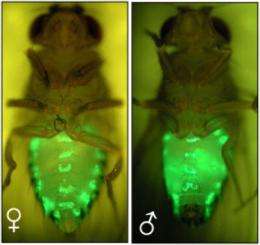Absent pheromones turn flies into lusty Lotharios

(PhysOrg.com) -- When Professor Joel Levine's team genetically tweaked fruit flies so that they didn't produce certain pheromones, they triggered a sexual tsunami in their University of Toronto Mississauga laboratory. In fact, they produced bugs so irresistible that normal male fruit flies attempted to mate with pheromone-free males and even females from a different species—generally a no-no in the fruit fly dating scene.
The study, published in the Oct. 15 issue of Nature, points to a link between sex, species recognition and a specific chemical mechanism, and is part of Levine's larger research into the genetic basis of social behaviour.
"This is important not only from the point of view of understanding social dynamics, but it's also fundamental biology, because these pheromones provide recognition cues that facilitate reproductive behaviour," says Levine, an assistant professor of biology. "Lacking these chemical signals (pheromones) eliminated barriers to mating. It turned out that males of other species were attracted to females who didn't have these signals, so that seemed to eliminate the species barrier."
In this study, they focused on recognition—how individual Drosophila melanogaster (fruit flies) know what their species is and what their sex is. While previous studies had suggested that pheromones played an important role, Levine's team decided to genetically eliminate a certain class of these chemicals, called cuticular hydrocarbon pheromones, to determine their particular effect.
The researchers found that female flies bred without the hydrocarbons were melanogaster Marilyn Monroes to normal males. But the effect didn't stop there—males lacking the hydrocarbons were also sexually irresistible. In fact, females lacking the hydrocarbons were so sexy that males of other Drosophila species courted them.
When the researchers treated females bred without the hydrocarbons with a female aphrodisiac, it restored the barrier preventing sex between species, suggesting that a single compound can provide species identity. "That means the same chemical signals and genes are underlying not only social behaviour in groups, like courtship and mating, but also behaviour between species."
Levine stresses that while pheromones are part of the human mating dance, the cues for attraction are far more complex in our species.
"Although I am no expert on human pheromones, there is evidence that men and women may discriminate odours from the same sex or other sexes differently, and there's even some evidence that how an individual discriminates those odours may reflect their gender preference," he says. "We may rely more on the visual system, and we may have a more complex way of assessing other individuals and classifying them and determining how we're going to relate to them than a fly does.
"But what we're looking at is a spectrum across biology of a tendency to understand how others relate to ourselves. It's clearly an issue that humans are caught up in—it's in our art, like Madame Butterfly and it's in our newspapers, in terms of sports issues like the recent controversy about the sexual identify of the South African runner Caster Semenya."
Source: University of Toronto (news : web)
















